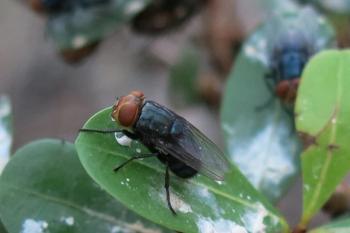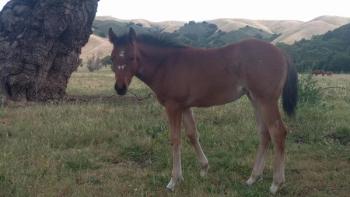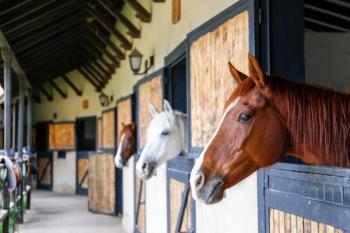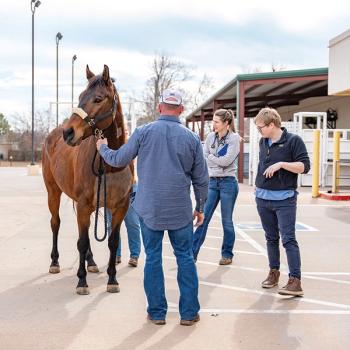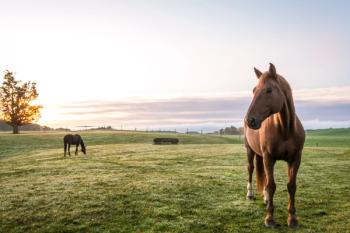
New horse racing rules adopted in New York state
Updated regulations adopted after spike in equine fatalities at Aqueduct Winter Meet in 2011-2012.
The New York Racing Association (NYRA) and the New York State Racing and Wagering Board (NYSRWB) recently adopted new regulations recommended by a Task Force of experts after 21 horses died or were euthanized at Aqueduct Race Track in Ozone Park, N.Y., during the NYRA winter meet of 2011 (held Nov. 30, 2011, to March 18, 2012). Most of deaths were due to musculoskeletal injuries.
In a letter dated March 14, 2012, from the office of New York Gov. Andrew Cuomo to NYRA President Charles Haywood, NYRA was advised to "hire a qualified independent investigator or team of investigators to review the circumstances involving these breakdowns, analyze the cause or causes and recommend any necessary action to [prevent] equine breakdowns at NYRA facilities."
A four-member Task Force of respected industry experts was appointed on March 22, 2012, at the NYSRWB's direction. The Task Force members were:
- Scott Palmer, VMD, DABVP, of New Jersey Equine Clinic and chairman of the AAEP Racing Committee
- Mary Scollay, DVM, equine medical director of the Kentucky Horse Racing Commission
- Alan Foreman, attorney, chairman and CEO of the Thoroughbred Horsemen's Association
- Jerry Bailey, retired jockey, inducted into the National Museum of Racing's Jockey Hall of Fame.
According to the official Report, issued Sept. 28, 2012, by the New York Task Force on Racehorse Health and Safety, "The incidence of racing fatalities was approximately double that recorded in the previous two years, and well exceeded the North American average for racing fatalities. This unusual cluster of injuries generated widespread public and industry concern."1
What the Task Force investigated
To try to rectify the governor's concerns, the Task Force's mandate included the following (see "What the Task Force investigated" for a more detailed list):
- Investigating the causes of the 21 horses' deaths at Aqueduct's meet
- Examining the condition of Aqueduct's inner track
- Reviewing and making recommendations on policies relating to public disclosures, necropsies, track conditions and pre-race examinations
- Examining the rules and practices relating to claiming procedures, veterinary procedures and drug use in horses.
Fatality causes outlined
According to the Report, of the 21 deaths, 18 fatalities were horses euthanized as a result of fractures sustained during racing—11 were associated with fracture of the right forelimb and seven with fracture of the left forelimb. One horse was euthanized a week after the race because of a severe soft tissue injury of the right hindlimb.
The remaining two fatalities were unrelated to musculoskeletal failure and were determined to be anomalies; thus, they were excluded from the relevant population of fatally injured horses when the Task Force considered potential interventions.
Separate from the analysis of the individual fatalities, the Task Force examined numerous other possible factors that might have contributed. These included racing surfaces, weather, the condition book, pre-race examination of horses, claiming races, shoeing practices, drugs and medication and extracorporeal shockwave therapy.
The Report stated, "The Task Force believes that there were missed opportunities for intervention to prevent these injuries. However, the Task Force does not intend for this Report to be used to find fault, assign blame or otherwise result in disciplinary action for events that occurred. This Report is intended to be a constructive analysis, identifying actions with the potential to prevent or mitigate injury to horses and riders, and our overall conclusions regarding the fatally injured horses as a group sets the stage for our recommendations."1
Conclusions
The Task Force formulated several conclusions, many of which are listed here from the Report1 (verbatim text is displayed in italics):
- There was no single event or circumstance that was responsible for the 21 racing fatalities.
- There were two significant anomalies that clearly distinguished this meet from previous one—a major infusion of cash into the purse structure from VLT revenues and the unusual weather.
- While larger purses have attracted better horses to New York Racing, the disproportionate increase of purses in the lower level claiming races incentivized poor decision-making by a range of stake holders.
- The unprecedented winter weather of 2011-2012, which featured unseasonably dry conditions and periods of warm temperatures, may have made it difficult to maintain consistent water content of the track, but the lack of scientific knowledge of the ideal surface moisture content makes it impossible to determine the significance of this finding. However, the unseasonably mild weather did eliminate periods of enforced rest ordinarily associated with routine winter conditions and weather related cancellations of training and racing.
- Some trainers may have failed to identify horses at risk, or failed to act appropriately to protect horses they recognized as at risk, likely in response to economic incentives.
- The most significant factor for fatal musculoskeletal injury in the racehorse is the presence of pre-existing injury. Many of the horses in this investigation were understood to have had pre-existing musculoskeletal conditions prior to the race in which they were fatally injured. The Task Force believes that the use of systemic or intra-articular corticosteroids may have impaired veterinarians and trainers in accurately assessing horses' soundness leading up to a race. The Task Force also believes that the use of these medications too close to the race may have limited the ability of the NYRA veterinarians to identify the presence of pre-existing conditions disposed to progressing to catastrophic injury.
- NYRA's organizational hierarchy, establishing veterinary department accountability to the Racing Office, created conflicts of interest and pressures that influenced the actions of NYRA veterinarians, resulting in inadequate protection of horses.
- Inconsistencies in NYRA Veterinary Department procedures and protocols compromised the ability of the examining veterinarians to identify horses at risk and intervene accordingly.
- NYRA veterinarians have the ability to require ultrasound, radiographic or other imaging modalities in special circumstances to identify pre-existing conditions that can lead to fatal musculoskeletal injury, yet there was no indication this was done in regard to any of the injured horses. This likely represented missed opportunities for a medical intervention to prevent injury in some cases.
- Numerous risk factors were found in the population of fatally injured horses, and while further validation of this tool is indicated, risk-factor assessment may assist in identifying horses of interest for the purposes of risk management, increased scrutiny, strategically timed examinations and possible intervention.
- The reluctance of jockeys and exercise riders to draw attention to horses they believed to be unsafe endangered horses and riders. The decision to prioritize prospective financial gain above personal safety is indicative of flawed thinking in which a hypothetical situation (future riding opportunities) supercedes a present reality of an unsound horse and risk of injury. If a rider is injured as a result of riding an unsound horse, the question of potential of future earnings becomes moot.
- Based on the information reviewed, the Task Force stated its belief that opportunities may have been missed to prevent the fatal injuries in 11 of the 21 horses included in the investigation.
The Report also stated that, in addition to the analysis of the individual fatalities and other possible factors that may have contributed to those fatalities, other matters pursuant to the Task Force's mandate or that warranted comment or recommendations as a result of its review included medical records, postmortem protocols and procedures, the equine injury database and risk factors, an equine medical director and NYRA governance.
The Report noted, "The Task Force believes that the safety of the horse and rider are core priorities for NYRA and should be prominently included in the NYRA mission statement."1 This, they felt, will help to shape the culture of NYRA to include a focus on the safety and welfare of horses and riders.
Recommendations
The Task Force made several recommendations in its final report:1
- Veterinary oversight of racing at NYRA's tracks should be the function of the state regulatory body and not NYRA. The veterinarians responsible for pre-race and other examinations and all other racing related responsibilities should be employed by the state and under the supervision of an equine medical director.
- The protocol requiring the NYRA Veterinary Department to report directly to the NYRA Racing Office is an unacceptable conflict of interest that must be changed immediately. Whether or not the state assumes responsibility for veterinary oversight, the NYRA Veterinary Department must report directly to the stewards.
- Veterinary Department practices and procedures must be developed and documented in a standard operating procedures manual.
- A standardized protocol for the initiation of scratches at the time of the pre-race examination must be developed, documented and implemented.
- A standardized protocol for the initiation of gate or post-parade scratch recommendations must be developed, documented and implemented.
- A standardized protocol for the assignment of horses to the veterinarian's list must be developed, documented and implemented.
- The use of a resource list should be abandoned.
- Protocols for the management and review of horses sustaining non-fatal conditions during a race must be developed, documented and implemented.
- Protocols for the management of horses sustaining fatal conditions during a race must be developed, documented and implemented.
- In the event of an increased occurrence of musculoskeletal injuries during a race meeting, the veterinary department should meet to review existing practices, develop strategies to reduce or mitigate injury occurrence, and enhance identification of horses for which intervention is warranted.
- The veterinary department also should develop and implement strategies intended to identify "horses of interest" that warrant increased scrutiny.
- Veterinary department employees should undergo a structured training program and regular reviews.
Task Force members speak out
"It is troubling that a lay person had the ability to direct veterinary activity," said Task Force member Mary Scollay during a news conference held upon release of the Report. "That oversight needs to be moved from the racing office, and the stewards should be the only ones allowed to process vet scratches."
Task Force member Alan Foreman noted, "It was very clear that during the Aqueduct meet the incidents of breakdowns were a serious problem, to the extent that there was concern Governor Cuomo might shut down Aqueduct and all of NYRA racing unless the cause or causes were investigated and steps were taken to ensure the safety of the horses and riders."
The Task Force, Foreman said, was given a dual mandate. The first was to investigate the causes of the 21 fatalities. The second mandate was much broader in a number of areas, including drug testing, medication issues, postmortem protocols, veterinary issues and track surface. In short, it was to see how the welfare and safety of the horses could be improved.
"We determined at the outset that we would leave no stone unturned," Foreman said. "We covered the landscape of possible factors that might have led to this spike in fatal breakdowns. We were not looking to point fingers or assign blame, but trying to find out what may have caused these fatalities so future breakdowns could be prevented and the racing environment made safer for horses and riders. We hoped we could create change within the industry to make it safer for any racehorse stepping on the track prior to a race."
Scollay said the Task Force worked as a group and reached consensus on every issue. "It was a team project; the Report speaks for itself," she said. "We were thorough, worked hard to be objective and fair, so there could be improvements."
The Task Force spent countless hours analyzing the circumstances of each equine death at Aqueduct, said Task Force Chairman Scott Palmer. "We found multiple factors that created a perfect storm of conditions that caused these tragic injuries. We produced realistic recommendations that will make a lasting difference in racehorse health and safety.
"The circumstances of this investigation represented a unique opportunity for making changes to racing policy," Palmer continued. "The AAEP made a number of recommendations during the past five years, though there has been very little movement for adopting those; [it's been] slow going in terms of implementation. That's because it's very difficult to make those changes in multiple racing jurisdictions.
"The situation in New York is unique at this time, as Governor Cuomo has taken control of the NYRA Board, and he is changing the NYSRWB, as well," noted Palmer. "This unusual situation created a unique opportunity to make changes that could not otherwise be accomplished."
Update
Two weeks after the Report was made public, the NYSRWB enacted emergency claiming and medication rules. "This prompt regulatory response is unusual, and the NYSRWB should be commended for their decisive action," said Palmer. "Though the political climate in New York was complicated by many unknowns during the past few months in terms of NYRA's organization, I believe Governor Cuomo's leadership and actions clearly indicate he is dedicated to ensuring that racing not only survives, but thrives in New York. Racing is a $4.2 billion industry in New York, and the Governor is very serious in making it successful. I am convinced Governor Cuomo wants to create a really strong, healthy and safe racing industry in New York."
"Many of the issues the Task Force identified are vulnerabilities throughout the industry as well," said Scollay. "To a certain extent, there are problems that need to be considered by the entire industry; it's not just Aqueduct (NYRA) alone."
Ed Kane, PhD, is a researcher and consultant in animal nutrition. He is an author and editor on nutrition, physiology and veterinary medicine with a background in horses, pets and livestock. Kane is based in Seattle.
Reference
1. New York Task Force on Racehorse Health and Safety. Investigation of Equine Fatalities at Aqueduct 2011-2012 Fall/Winter Meet. Available at:
Newsletter
From exam room tips to practice management insights, get trusted veterinary news delivered straight to your inbox—subscribe to dvm360.


